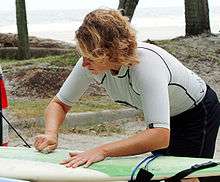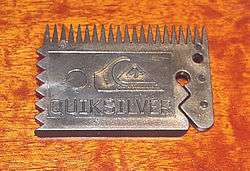Surfboard wax
Surfboard wax (also known as surfwax) is a formulation of natural and/or synthetic wax for application to the deck of a surfboard, bodyboard, or skimboard, to keep the surfer from slipping off the board when paddling out or riding a wave. It is also used to increase grip on the paddle of a surf kayak or dragon boat.

Surfboard wax is generally composed of a mixture of paraffin, beeswax or other hard waxes; petroleum jelly can also be added to create a softer wax. Often exotic scents like coconut or bubblegum are added to give the wax an attractive scent. There are also natural alternatives available containing only organic substances like beeswax, vegetable oils (such as coconut or hemp oil), pine resin, tree pulp and natural essential oils. Many different commercial brands and varieties of surfboard wax optimized for different climates and water temperatures may be found at a surf shop.
Removal
A plastic scraper (typically found on the back of a wax comb) can be used to remove surfboard wax in large chunks. Residual wax that has not been removed by scraping can be removed with a soft cloth, either on its own or in combination with (for example) coconut oil. Various commercial solvents are also available but can damage the surfboard or its detailing. Surfers will also sometimes intentionally allow surfboard wax to melt in the sun, making the wax easier to remove.
Wax comb

A wax comb is a tool used in the maintenance and removal of surfboard wax on a surfboard. Wax combs typically have features such a jagged or toothed edge and a straight, relatively sharp edge. The jagged edge is used to create textured grooves for improving the traction of the wax and the straight edge is used for scraping off unwanted wax.[1] In addition to the straight edge for wax removal, some wax combs even have an inwardly curved edge for the rails (such as Mr. Zog's Sex Wax “Sex Comb”).[2] Additionally, wax combs can have features such as fin key, bottle opener or a snap for portability (attachment to interior pocket loop, lanyard or leash attachment lanyard).[3]
Temperature
Most surfboard wax comes labeled with a water temperature range for which it is ideal. Wax used in water colder than its rating will become hard and not provide the stickiness needed to stay on the board, while wax used in water warmer than its rating may melt. This makes application of the correct type of wax important.
Application

Surfboard wax is applied by first putting a base coat onto the clean board. This harder base coat forms a bump pattern on the surfboard which the surfer will then stick to. The base coat is then topped with a top coat of wax of an appropriate temperature.[4]
When re-applying surfboard wax it is always crucial to remove all prior layers of wax in order to ensure the best results.[5]
See also
- Muffin Wax
- Ski wax
- Mr. Zog's Sex Wax
- Surf Wax America
References
| Look up surfboard wax in Wiktionary, the free dictionary. |
- Curtin, Ryan. "How To Use A Surfboard Wax Comb".
- "Surf Wax 101".
- "Surfing Wales: Wax".
- John Dang. "How To Wax A Surfboard". surfscience.com. Retrieved March 30, 2010.
- "How to wax a surfboard - Disrupt Surfing". Disrupt Surfing. Retrieved 2015-12-21.